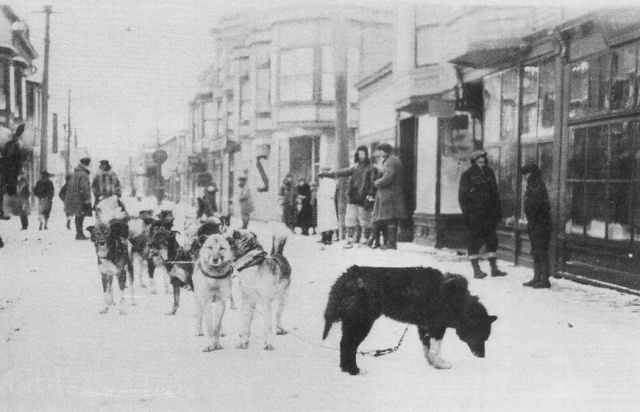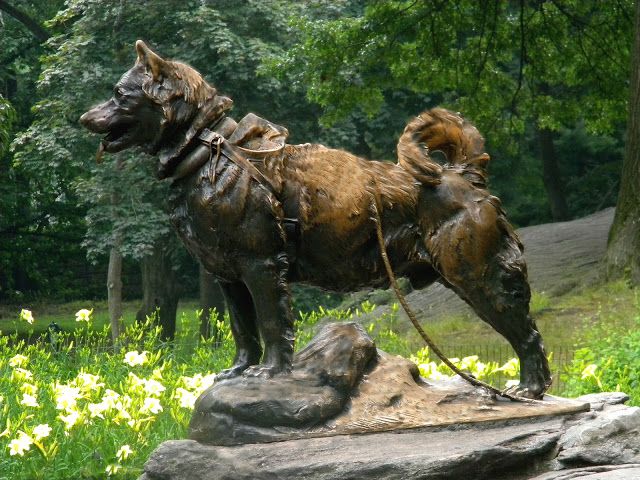Written by
Australian Dog Lover
12:34:00
-
0
Comments
Balto was a black and white Siberian Husky (1919 - 14 March 1933) sled dog who led his team on the final leg of the 1925 serum run to Nome, in which diphtheria antitoxin was transported first by train and then by dog sled to Nome to combat an outbreak of the disease.
BACKGROUND
Of unknown parentage, Balto came from the Chukchi Inuit stock of Siberia and displayed white “socks”, “bib”, and partial white markings on the belly and tip of the muzzle, which advanced with age (including white markings around his eyes when he was old).
Balto was named after explorer Samuel Johannesen Balto, a Norwegian "Sami" who was hired by his fellow Norwegian, explorer Fritdjof Nansen, to accompany him on his expedition to Greenland in 1888.
The "Sami" are an Arctic reindeer herding people who live in northern Norway, Sweden, Finland and Russia.
Balto's owner was Leonhard Seppala, a Norwegian breeder and racer of Siberian dogs who trained both dogs and mushers.
He was employed by Jafet Lindeberg’s Pioneer Gold Mining Company (Jafet Lindeberg was one of the “Three Lucky Swedes” who discovered gold at Anvil Creek in 1898, near Nome).
Balto ran more true to the usual size for a Siberian Husky at the time at about 55-60 pounds. However he was not considered breeding material by his owner as he did not "cut" a racing profile. His body was deemed a little boxy and he had a barrel chest but these "flaws" also made him very strong. However, all of this doomed Balto (in the eyes of Seppala) as a lead dog prospect. He was neutered at six months of age, and assigned only to working on the freighting teams.
THE 1925 NOME SERUM RUN
In January 1925, doctors realised that a potentially deadly diphtheria epidemic was poised to sweep through Nome's young people. The only serum that could stop the outbreak was in Seattle, Washington. The engine of the only aircraft that could quickly deliver the medicine was frozen and would not start. After considering all of the alternatives, officials decided to move the medicine via multiple dog sled teams.
The serum was transported by train from Seattle to Nenana, where the first musher embarked as part of a relay aimed at delivering the needed serum to Nome. More than 20 mushers took part, facing a blizzard with −23 °F (-31 °C) temperatures and strong winds.
The longest and most hazardous stretch of the run was actually covered by Leonhard Seppala, and his dog team, led by Togo. They came from Nome towards the end of the run and picked up the serum from musher Henry Ivanoff.
The serum was later passed to Gunnar Kaasen. Balto proved himself on the Iditarod trail, saving his team in the Topkok River. Balto was also able to stay on the trail in near whiteout conditions; Kaasen stated he could barely see his hand in front of his face. Balto's team did their leg of the run almost entirely in the dark. The final team and its sledder were asleep when Balto and Kaasen made it to the final stop, so Kaasen decided to continue on.
 |
| On February 2, 1925, the Norwegian Gunnar Kaasen drove his team, led by Balto, into Nome |
Katie Pryor interviewed each musher after he had finished and news coverage of this event was worldwide.
AMERICAN TOUR AND WORLWIDE FAME
Togo was the star dog for Leonhard Seppala even before the great 1925 Serum Run. Instead of celebrating the triumph together as one huge team, many became jealous of the publicity Balto received, especially from President Calvin Coolidge and the press. Seppala favoured Togo, but the general public loved the story behind Balto, and so they would take a far different path after the celebrations were over. Balto was not welcomed at the ceremony in New York in which Seppala and Togo received awards from the explorer Roald Amundsen.
By late February of 1925, an enticing offer had come to Kaasen's attention, to bring the team down to the United States to appear in a movie about their experiences. Gaining clearance from Seppala (who was angry with all the attention Balto was getting from the press, while Togo was getting practically none), Kaasen travelled south to Seward with his wife Anna, and the dog team (including their sled), where they boarded the steamship Alameda, bound for Seattle, Washington.
Hollywood producer Sol Lesser met them a few weeks later, and quickly organized the shoot for his movie Balto's Race To Nome. While the team was in the employ of Lesser, they were housed in the kennels of the studio where Lesser worked. There are some stories which state that Balto, like the Kaasens, received his own luxurious suite in Los Angeles' Biltmore Hotel!
Togo was the star dog for Leonhard Seppala even before the great 1925 Serum Run. Instead of celebrating the triumph together as one huge team, many became jealous of the publicity Balto received, especially from President Calvin Coolidge and the press. Seppala favoured Togo, but the general public loved the story behind Balto, and so they would take a far different path after the celebrations were over. Balto was not welcomed at the ceremony in New York in which Seppala and Togo received awards from the explorer Roald Amundsen.
By late February of 1925, an enticing offer had come to Kaasen's attention, to bring the team down to the United States to appear in a movie about their experiences. Gaining clearance from Seppala (who was angry with all the attention Balto was getting from the press, while Togo was getting practically none), Kaasen travelled south to Seward with his wife Anna, and the dog team (including their sled), where they boarded the steamship Alameda, bound for Seattle, Washington.
 | |
|
During the west coast tour, Kaasen caught wind of an announcement, by the New York City Commissioner of Parks, that a monument was to be dedicated in Central Park (in the city) to honour the sled dogs and mushers who took part in the Serum Run. It would be topped by a bronze statue of Balto (designed by the famous animal sculptor Frederick Roth).
Kaasen finished up with his commitments to Sol Lesser and, under the auspices of a new tour promoter, took the team on a nine-month vaudeville circuit of the United States, to the delight of the American citizens who had read about Balto in the newspapers.
The east-bound leg of the tour ended in New York City where, on December 16th, the statue and monument were unveiled in a solemn ceremony. Kaasen had Balto with him, and appeared in his squirrel-fur coat and wolf-fur pants.
 |
| Balto and Gunnar Kaasen |
The east-bound leg of the tour ended in New York City where, on December 16th, the statue and monument were unveiled in a solemn ceremony. Kaasen had Balto with him, and appeared in his squirrel-fur coat and wolf-fur pants.
Balto however was soon relegated to being neglected on the vaudeville circuit with his team. When Kaasen wished to return home to Alaska, his dogs were sold to the highest bidder by the company who sponsored his tour. The dogs ended up chained in a small area in a novelty museum and freak show in Los Angeles.
While visiting Los Angeles, George Kimble, a former prize fighter turned businessman from Cleveland, was shocked to discover the dogs were unhealthy and badly treated. Mr. Kimble worked together with The Plain Dealer newspaper to bring Balto and his team to Cleveland, Ohio. On March 19, 1927, Balto and six companions were brought to Cleveland and given a hero's welcome in a triumphant parade. The dogs were then taken to the Brookside Zoo (now the Cleveland Metroparks Zoo).
BALTO'S LEGACY
Partially deaf and blind, and suffering from canine arthritis in his rear legs, Balto was being cared for by the team’s keeper “Captain” Curley Wilson. There were concerns about his failing health in 1933, until a kindly veterinarian, Dr. R.R. Powell offered to ease Balto’s suffering. Wilson accepted for the zoo, and carefully moved Balto over to Dr. Powell’s animal hospital. Powell insisted on caring for Balto free of charge, stating it was an honour to care for him in his last hours.
His body was stuffed and mounted by a staff taxidermist at the Cleveland Museum of Natural History, where it stands to this day. In October 1998, Balto left for a five-month stay at the Anchorage Museum of History and Art which drew record crowds.
While visiting Los Angeles, George Kimble, a former prize fighter turned businessman from Cleveland, was shocked to discover the dogs were unhealthy and badly treated. Mr. Kimble worked together with The Plain Dealer newspaper to bring Balto and his team to Cleveland, Ohio. On March 19, 1927, Balto and six companions were brought to Cleveland and given a hero's welcome in a triumphant parade. The dogs were then taken to the Brookside Zoo (now the Cleveland Metroparks Zoo).
 |
| A statue of Balto in New York's Central Park (unveiled December 17, 1925) |
Partially deaf and blind, and suffering from canine arthritis in his rear legs, Balto was being cared for by the team’s keeper “Captain” Curley Wilson. There were concerns about his failing health in 1933, until a kindly veterinarian, Dr. R.R. Powell offered to ease Balto’s suffering. Wilson accepted for the zoo, and carefully moved Balto over to Dr. Powell’s animal hospital. Powell insisted on caring for Balto free of charge, stating it was an honour to care for him in his last hours.
His body was stuffed and mounted by a staff taxidermist at the Cleveland Museum of Natural History, where it stands to this day. In October 1998, Balto left for a five-month stay at the Anchorage Museum of History and Art which drew record crowds.
In 1965 Carl Barks introduced a hero dog named "Barko" as a character in a book "North of the Yukon", as an homage to Balto.
The 1995 animated film of the same name was also made, loosely depicting Balto's famous journey. This film portrayed him as a wolf-dog hybrid and is voiced by Kevin Bacon.
The 1995 animated film of the same name was also made, loosely depicting Balto's famous journey. This film portrayed him as a wolf-dog hybrid and is voiced by Kevin Bacon.









No comments
Post a Comment